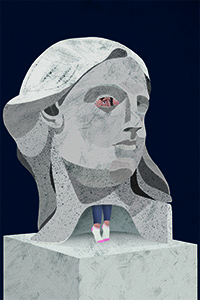Visualising Vulnerability
Visualising Vulnerability trialled creative design methods to help students studying mental health subjects better understand the emotional and mental states they are studying. The series of workshops also helped students to understand their own emotional vulnerability.
This pilot programme aimed to explore mental illness through drawing, making and designing to reduce stigma around asking for help when dealing with mental health issues. The programme created a safe space where students could develop a language to express their own feelings of vulnerability without judgement.
 Over a series of workshops, student participants explored mental states through different sensory experiences. They discussed images whilst listening to music played to patients during MRI scans in order to trigger different emotions; evaluated vignettes representing the struggles of young people; and designed physical objects to represent different emotional states. Students explored and articulated different using visual, written and spoken-word mediums, enabling them to connect to the ‘human’ aspect of their studies.
Over a series of workshops, student participants explored mental states through different sensory experiences. They discussed images whilst listening to music played to patients during MRI scans in order to trigger different emotions; evaluated vignettes representing the struggles of young people; and designed physical objects to represent different emotional states. Students explored and articulated different using visual, written and spoken-word mediums, enabling them to connect to the ‘human’ aspect of their studies.
The work of the students was then used as the basis for a design brief for a professional illustrator. This led to a series of graphic images that powerfully visualise and externalise the hidden mental states that the students had explored. These are now on permanent display at the IOPPN where they continue to inform reflection and discussion.
‘Visualising Vulnerability’ allowed students to talk more freely about their own experiences and emotions, which in turn helped them to connect with and understand the mental illnesses they were studying. The student organisers also reported that the programme helped students develop a language that could help to build greater empathy with patients.
Student feedback
[We are] always looking at the theory of mental illness, never at how to describe/ express it!
Being able to use creativity to explore mental health difficulties is something I find invaluable. Sometimes it is so hard to work out how to say what you are feeling in words and yet having the possibility to make, draw, create and design without a specific end goal enables you to explore without words and maybe, just maybe understand whatever it is a little bit more.”
Sasha Mattock, Student Organiser, MSc graduate in Clinical Neurodevelopmental Disorders
Great to immerse in and explore how emotions are felt and how everyone checks something different.
Project team
Academic lead
Dr Patricia Zunszain, Senior Lecturer
Institute of Psychiatry, Psychology and Neuroscience
Sasha Mattock, MSc student in Clinical Neurodevelopmental Disorders
Sarah Atayero, MSc graduate in Affective Disorders The Liminal Space